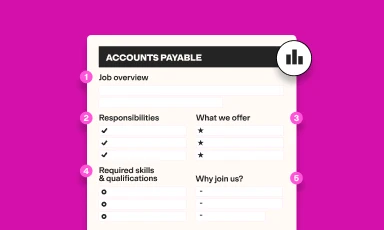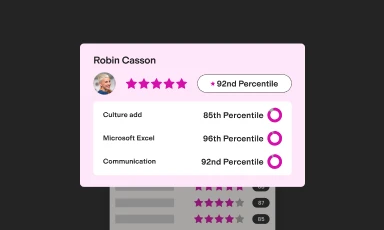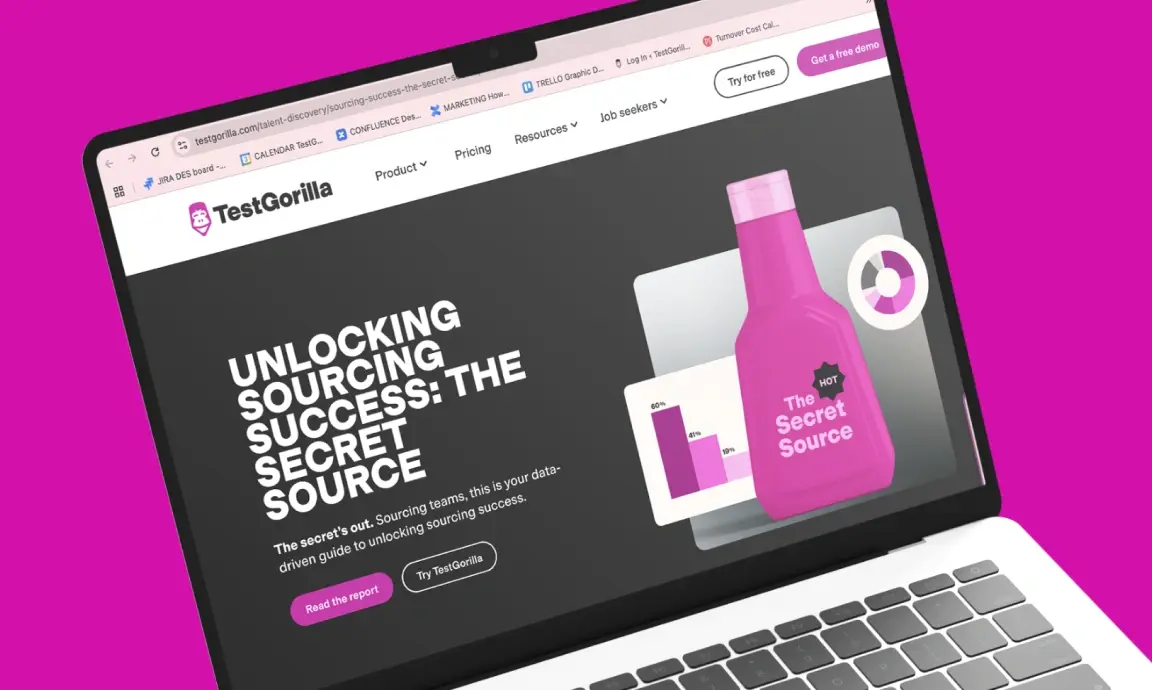21 user interview questions to ask talented professionals
Are you trying to assess a usability testing engineer for your organization? Since these experts have many responsibilities, such as gathering data to enhance applications, you must assess multiple skills to find the right professional.
Skills assessments that include a QA skills test are the ideal starting point, but completing interviews with candidates is also crucial.
You should keep your candidates engaged during the interview with the right questions. So where should you start when making a list?
Check out 21 of the best user interview questions to ask talented professionals below to begin making your own list.
21 user interview questions about experience, skills, and processes
The 21 user interview questions we’ve gathered focus on experience, skills, and processes. Choose from our list of questions to begin assessing each of these factors and learn about your candidates during the interview phase.
1. Describe your usability testing experience.
By analyzing answers to this user interview question, you can gauge whether your applicants are familiar with usability testing. Candidates should know the basic principles of the usability testing process and provide examples of their previous projects.
For example, applicants might have created usability testing questions for a specific application, such as a travel app, and asked customers to test their experience using the orders feature.
When reviewing responses, ensure your candidates’ experience aligns with your expectations. If not, check if they can embrace your role’s responsibilities.
2. Please tell us what user testing is.
Applicants should know user testing is critical to the software development cycle and design process. This approach can help teams understand the needs of their customers or clients and spot any issues with usability.
With user testing, usability testing engineers can make better decisions to improve the product and determine whether it will be successful with customers. The process can also help them learn if customers understand the product and implement the best design practices to succeed when the team releases the application.
3. Why is attention to detail vital for usability testing engineers?
Attention to detail is vital for usability testers because it helps them notice defects in the product earlier in the development cycle, enabling software testers to fix them before customers use the product. But this is only one example of how attention to detail is important.
Observing, evaluating, and planning during usability testing also require attention to detail. Every step of the process involves paying attention to each factor contributing to the users’ unique experiences.
With the benefits of attention to detail in mind, ensure your candidates have this ability using our Attention to Detail test.
4. Name two factors that can change the user experience.
If applicants have experience with enhancing the user experience (UX), they’ll know the factors to watch out for during this process. Look for responses that mention the following elements:
Usability: Users should be able to navigate the site or application without effort. The app’s usability depends on its structure, which should mitigate the need for support and create a seamless experience.
Security: Companies must provide users with a secure experience to build trust. With SSL certificates and content delivery network installation, teams can enhance the application’s security. They can also use firewalls and keep the site updated to achieve this goal.
Some other factors can affect UX, including design consistency, accessibility, and credibility. Check if candidates understand these factors and have experience dealing with them in recent projects.
5. Why should you complete a pre-test survey? What does it help you achieve?
If usability testing engineers want to measure crucial factors that could affect UX, they should give users a pre-test survey. This involves asking the users a few specific questions about their technical expertise or demographic.
Based on the users’ responses, user testing engineers can better understand the context of their experience.
For instance, they might know that clients who lack technical expertise might find it challenging to use the application. In this case, they can work with specific users who say they’re not technical experts to make the application more suitable for this demographic.
6. Explain why user demographics are essential in usability testing.
By acknowledging specific user demographics, usability testing engineers can understand why a target market prefers certain product features. Your candidates should understand that demographic data like gender, age, and education level can all affect how users interact with a product.
Candidates who can provide specific examples of how demographic data can affect a product are the ones to consider for your vacancy. For example, they might mention that having information about their users’ cultural differences can help them create a universal design that suits various cultural contexts.
7. Please tell us why communication skills are crucial for usability testing engineers.
Communicating with many people is a fundamental part of a usability testing engineer’s role, which is why they require communication skills. Applicants who understand that sharing data with developers, application testers, users, and designers is more straightforward with advanced communication skills are a good match for your vacancy.
Statistics show that 86% of employees believe poor communication is the main cause of failures in the workplace. It can also make it difficult for technical experts to share their findings with non-technical stakeholders.
The simplest strategy for assessing your applicants’ communication skills is with our Communication skills test. Integrate this test into your assessment to evaluate candidates thoroughly.
8. Explain why post-testing questions are critical in usability testing. Name some best practices for creating post-testing questions.
To gather feedback related to UX, usability testing engineers should ask the right post-test questions. Applicants must be aware of some key best practices to get the most useful responses to these questions, such as to:
Ask concise questions
Avoid asking leading questions
Ensure the questions relate to the research goal
If they want to provide more details, your interviewees might explain why avoiding specific adjectives is essential when asking post-testing questions. They’ll know that some words can plant positive or negative ideas about feedback into the user’s head or coax a participant into providing a biased response.
Therefore, user testing engineers should ask neutral and open questions to receive honest, bias-free feedback.
9. What is the echoing technique in usability testing? Why would you use it?
The echoing technique in usability testing refers to repeating the final phrase in the user’s response to a question when receiving feedback. A usability testing engineer should use the echoing technique to ensure they don’t yield biased responses from the participant.
Top responses to this question will include examples of the echoing technique in action.
For example, if a user states that the drop-down menu is confusing, the testing engineer might echo this statement and follow up with another question by saying, “You find the drop-down menu confusing. What do you find confusing about it?” This strategy also encourages the user to provide developers with more information and feedback.
10. Do you have a strategy to gather user impressions?
Each candidate might have unique strategies to create a user impression ranking process, and they’re usually related to the user’s processes. However, there are a couple of important strategies your candidates might know about.
The first is the five-second test. The average amount of time users spend on websites is dropping rapidly, so getting their attention early on is vital to avoid losing potential clients.
With the five-second approach, testers ask users to complete a simple survey to determine if the website or application engages them within the first five seconds of viewing it.
The second is the first-click approach. This method involves learning how easy it is for users to complete specific tasks when using the application or web page.
For example, usability testing engineers might ask clients to click on the shopping basket on an e-commerce website. They can then record the position of the click to evaluate how effective their design’s linking structure is.
11. What do you understand about quantitative data for usability tests?
Answers to this user interview question will reveal if your candidates understand quantitative data and why it’s important. Applicants should know that this data type includes numerical values, like percentages or rankings, which users may provide usability testers.
Quantitative data is objective, making it suitable for usability testing. It ensures the feedback the engineer receives is easy to assess and unbiased.
12. Please explain why UX skills are essential for usability testing engineers.
One crucial advantage of having UX knowledge is that it helps engineers ensure products meet users’ needs, such as making sure navigation is simple and the button sizes are suitable. UX skills give them insights into whether the users have a positive experience with the application.
UX testing can also help teams find ways to improve UX, so your candidates must have experience with checking the quality of their interactions to implement required changes.
Before hiring a developer, integrate our UX/UI Design test into an assessment to learn if your applicants have UX knowledge and an eye for design.
13. Please tell us how qualitative data is important for usability tests.
Qualitative data includes verbal or written responses to usability testing questions. This data is subjective – users provide these responses when answering open-ended questions.
Candidates who can provide examples of qualitative data might be qualified for your role. For instance, a tester might ask, “How can we improve the shopping cart icon?” Users could respond by saying, “Perhaps the icon could be smaller.” This data reveals what the user prioritizes in an application.
14. How are qualitative and quantitative data different when it comes to usability tests?
If applicants have gathered both qualitative and quantitative data in their usability testing career, they’ll know how these data types differ. Look for responses that explain that qualitative data can be verbal or written and is more subjective than quantitative data.
Candidates should also know that working with quantitative data often involves identifying statistical trends in user testing by examining rankings or comparing figures. On the other hand, testers collect qualitative data by studying detailed, personal reactions to an application or web page.
15. Which factors would you inform users about before beginning a usability testing process?
When engineers begin a usability testing process, they should talk to users about each part of the process and inform them of how they will be completed. Applicants should provide examples of these steps when responding to this user interview question.
For instance, if they will be performing usability testing for an e-commerce website, they might list the following testing steps:
Check if the user can edit their shopping cart
Assess how easily they can search for items
Review if the user can add several items to the shopping cart
Consider if your candidates know to ask their users questions before the testing process begins, which can make the procedure more efficient.
16. What are the main goals of usability testing?
There are a few main goals of usability testing, and applicants should be able to name some of them. By asking this interview question, you can learn if your applicant has sufficient knowledge to achieve crucial usability testing outcomes.
Some of the main usability testing goals include the following:
Find out why clients may select the developer’s application instead of another option
Check for problems with the product
Learn how to improve the product
If you need to learn about your applicants’ usability testing experience, don’t forget to ask follow-up questions like “How would you use feedback to learn how to improve the product?” This approach can help you determine which applicants fully understand the specific usability testing goals and how they are related.
17. Explain why problem-solving skills are fundamental for usability testing engineers.
To identify problems in existing designs, usability testing engineers must have good problem-solving skills. These skills can also help engineers create techniques to improve the product’s usability.
Statistics show that 51% of IT managers look for problem-solving skills in their candidates, including usability testing engineers.
One easy way to assess problem-solving skills is by asking how candidates solve common usability testing issues, such as getting quantitative data from users. You can also use our Problem Solving skills test to evaluate your applicants’ ability to analyze problems and make the best decisions.
18. Do you have a list of questions you would ask users during the pre-test screening stage?
Candidates should know that asking users questions during prescreening can help testers measure how much specific factors affect the user’s experience – such as interactive elements and simple navigation.
However, the top answers to this user interview question will also include several insightful questions that candidates would ask users during this stage.
Your candidates should ask questions related to the user’s demographics, like “What is your job?” Some other useful questions could include “How often do you use technological applications?” or “In which situation would you use this application?”
If candidates have a list of go-to questions, you’ll know they are prepared to complete usability testing duties for your company.
19. Should testers learn about a user’s previous product knowledge when they participate in user testing?
Usability testing engineers must be aware of a user’s previous product knowledge when they participate in user testing. Applicants should also explain why this is important in their answers.
Testers should understand how users interact with a product and the problems they may encounter when using them. For example, if a user lacks experience with e-commerce websites, they might find it challenging to use the shopping basket tool on such a website.
However, if a usability testing engineer understands this context, they can anticipate these problems and make the application more user-friendly.
20. Should testers give users much guidance when participating in a usability test?
Ask candidates this question to find out whether they know the best usability testing practices. Candidates should know that giving little guidance can be beneficial to testers. This approach helps them measure whether the user can understand the application on their own based on its design and structure.
They should also be aware that too much guidance can hinder usability testing because testers won’t receive the right data to help them improve the product. Instead, they should welcome users’ questions during testing to identify ways to enhance the product’s features.
21. Please explain why you should ask open-ended questions in usability testing.
With open-ended questions, testers can receive more insight into the user’s thoughts about the product. They can then use this information to alter the application to suit the user’s requirements.
The ideal responses will also compare open-ended questions with closed-ended ones. Candidates who know that closed-ended questions do not always elicit a full response from users are ideal for your vacancy. However, check if they have experience asking open-ended questions during testing to get a sense of their working style.
How should you use skills testing with user interview questions?
You should invite candidates to complete skills tests before asking user interview questions. Once you have applicants’ test results, you can determine which usability testing engineer applicants have the skills you’re looking for and ask them to attend an interview.
Here are some of the main advantages of using skills assessments before asking candidates user interview questions in an interview:
Replace the time-consuming resume-screening method
Assess several skills simultaneously
Test candidates for personality and culture add
Select top candidates for your interview and save time
It’s best to send candidates an assessment when they first respond to your job ad. This approach will help you keep time-to-hire metrics low and create a shortlist of top candidates right at the start of the hiring process.
The best insights on HR and recruitment, delivered to your inbox.
Biweekly updates. No spam. Unsubscribe any time.
Ask candidates user interview questions to hire talented professionals
The hiring process doesn’t have to involve many steps or rounds of testing. All you need to do is use skills tests like our QA test in your assessments. Then you can choose the applicants with the best test results and ask them user interview questions.
If you’re searching for the best skills-testing platform, look no further than TestGorilla.
We have everything from personality and culture tests to programming skills tests to help you find the best user testing engineer. Experts craft our tests to be reliable and save you time, ensuring your time-to-hire metrics are low and the candidate experience is excellent.
We recommend that you tour our platform and learn about its features to begin creating a simple candidate assessment process.
Sign up for a free account with TestGorilla to track down the ideal applicant for your team.
Related posts
You've scrolled this far
Why not try TestGorilla for free, and see what happens when you put skills first.



















